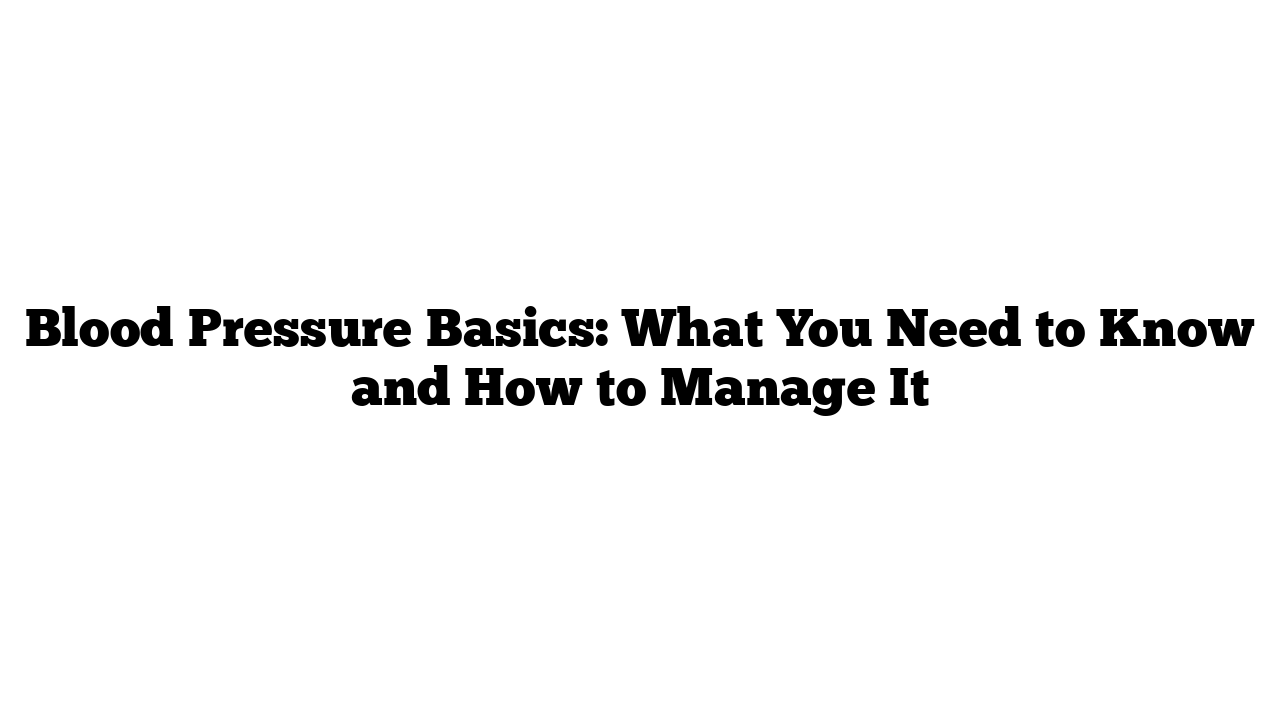Understanding Blood Pressure: The Key to a Healthy Heart
Have you ever wondered why blood pressure is so crucial? It’s a vital sign checked during almost every healthcare visit. While it provides essential insights into your cardiovascular health, high blood pressure—often referred to as the “silent killer”—can significantly increase your risk of serious conditions like stroke, heart attack, kidney failure, and even aneurysms if left untreated.
Today, we’ll define blood pressure, explore the ideal ranges, discuss how to measure it, and share effective strategies to keep it within a healthy range.
What is Blood Pressure?
Blood pressure follows a principle that you might know as the “Goldilocks Principle.” Just like Goldilocks preferred her porridge not too hot or too cold, blood pressure needs to be “just right.” If it’s too low, your tissues won’t receive enough oxygen; if it’s too high, the pressure can damage tissues and blood vessels over time, leading to various health issues.
Most people deal with high blood pressure, or hypertension, rather than low blood pressure. To understand blood pressure better, think of it as the force exerted by blood against the walls of your arteries as your heart pumps it through your body.
The equation for blood pressure is:
Blood Pressure = Cardiac Output × Systemic Vascular Resistance
- Cardiac Output: This is the amount of blood your heart pumps per minute, influenced by your heart rate and the strength of each heartbeat. As cardiac output increases, so does blood pressure.
- Systemic Vascular Resistance: This refers to the resistance blood vessels create as blood flows through them. Factors affecting this include how constricted or relaxed the blood vessels are, their length, and their elasticity (or compliance).
Healthy arteries are critical for maintaining normal blood pressure. Plaque buildup can stiffen arteries, leading to higher blood pressure.
Understanding Blood Pressure Readings
Blood pressure is measured in millimeters of mercury (mm Hg) and recorded as two numbers:
- Systolic Pressure (top number): The pressure in your arteries when your heart beats.
- Diastolic Pressure (bottom number): The pressure in your arteries when your heart rests between beats.
Normal vs. Unhealthy Blood Pressure Numbers
- Normal: Systolic < 120 and Diastolic < 80
- Elevated: Systolic 120–129 and Diastolic < 80
- Stage 1 Hypertension: Systolic 130–139 or Diastolic 80–89
- Stage 2 Hypertension: Systolic ≥ 140 or Diastolic ≥ 90
Proper Measurement Techniques
To ensure accurate readings, follow these steps:
- Relax for at least 5 minutes before measuring.
- Sit in a chair with your feet flat on the floor and your back supported.
- Avoid caffeine, exercise, and smoking for at least 30 minutes before the measurement.
- Ensure your bladder is empty.
- Do not talk during the rest period or while taking the reading.
- Support your arm on a desk or your side.
Why Should You Care About Blood Pressure?
High blood pressure often goes unnoticed because it’s usually asymptomatic. Most people only notice symptoms when blood pressure is extremely high. Untreated hypertension can lead to severe health issues, including:
- Heart Damage: Over time, high blood pressure can make your heart work harder, potentially leading to heart failure.
- Aneurysms: High blood pressure increases the risk of developing aneurysms, which can be life-threatening if they burst.
- Organ Damage: Hypertension can damage blood vessels in the kidneys, leading to kidney disease and failure.
How to Lower Your Blood Pressure
Fortunately, there are effective ways to manage and lower your blood pressure:
- Exercise Regularly: Engaging in aerobic exercise and resistance training can lower systolic blood pressure by about 4-6 mm Hg and diastolic pressure by about 3 mm Hg, even without weight loss.
- Maintain a Healthy Diet: Reducing sodium intake and following the DASH (Dietary Approaches to Stop Hypertension) diet—rich in fruits, vegetables, whole grains, and low-fat dairy—can significantly improve your numbers.
- Limit Alcohol Intake: Drinking in moderation can help maintain healthy blood pressure levels. For men, that’s up to two drinks a day; for women, one drink a day.
- Weight Management: Losing weight can lead to a reduction of 0.5 to 2 mm Hg for every kilogram lost.
- Stress Management: Practice relaxation techniques, like meditation or yoga, to help reduce stress levels.
If lifestyle changes aren’t enough to manage your blood pressure, medications may be necessary. However, many healthcare providers recommend trying lifestyle modifications first, as these can significantly impact overall health.
Final Thoughts
In conclusion, maintaining healthy blood pressure is crucial for your overall health and well-being. Regular check-ups and awareness of your numbers can help you manage your risk. If you’re looking for more information about cardiovascular health, check out our resources on how exercise affects your heart.
Thank you for reading! If you found this information helpful, please consider sharing it with others who might benefit.
